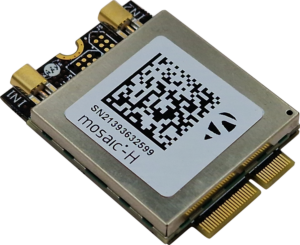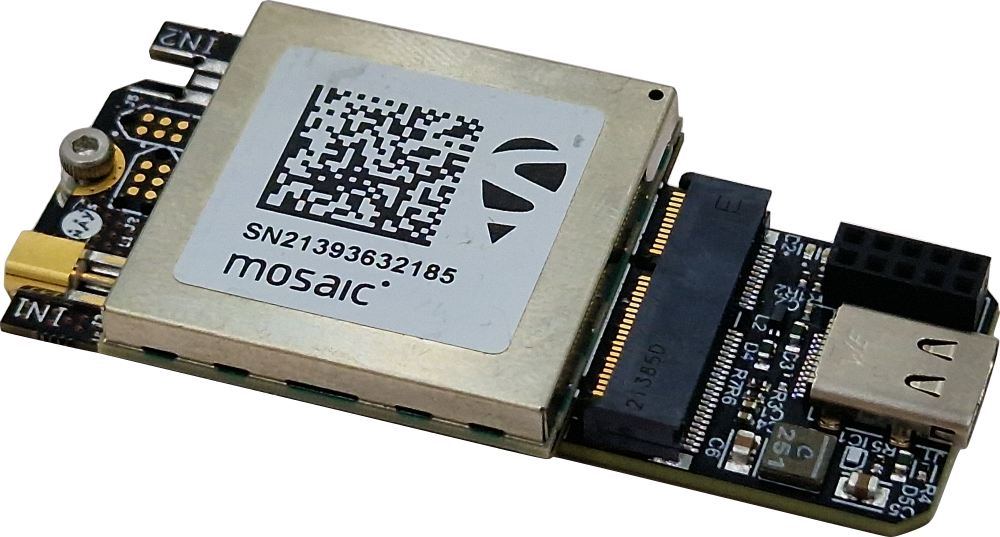Products
M.2 GNSS Receiver Cards
The ANavS® GNSS receiver cards provide precise position, velocity and attitude information. It can be easily integrated into your application. The M.2 Key E format is a common standard for industrial PCs, Embedded PCs or development boards (e.g. Nvidia Jetson boards). With adapter boards the cards can also be used with USB or Mini PCIe.
ANavS® GNSS receiver cards can be equipped with the following chipsets:
- Septentrio MOSAIC-X5
- Septentrio MOSAIC-H (Heading-Version)
- Septentrio MOSAIC-T (Timing-Version)
- U-Blox ZED-F9P/K/R
Key Facts for MOSAIC X5
No compromises: The best of both worlds: small sized with solid performance. High update rates (>100 Hz) and low latency, both are crucial for control systems of any type of autonomous applications. High accuracy centimetre level positioning. Multi-constellations and multifrequency. Full L2 support via P(Y) code.
Advanced technologies inside: Septentrio’s GNSS+ toolset enables accuracy and reliability in the
toughest conditions through:
AIM+ the most advanced on-board interference mitigation technology on the market (narrow and wide band, chirp jammers).
LOCK+ for robust tracking during high vibrations and shocks.
APME+ multipath mitigation to disentangle direct signal and those reflected from nearby structures.
IONO+ provides advanced protection against ionospheric disturbances.
Allowing you to carry on with the highest possible efficiency.
Centimeter Positioning Accuracy
- Precise absolute RTK positioning:
Horizontal accuracy: 0.6 cm + 0.5 ppm
Vertical accuracy: 1 cm + 1 ppm
Initialisation time: 7 s
Multi-GNSS, Multi Frequency RTK/PPP Technology
- GPS (L1C/A, L1C, L1PY, L2C, L2P, L5)
- Galileo (E1, E5a, E5b, E5 AltBoc, E6)
- GLONASS (L1CA, L2CA, L2P, L3)
- Beidou (B1I, B1C, B2a, B2I, B3)
- QZSS (L1C/A, L1C, L2C, L5, L6)
- SBAS (Egnos, WAAS, GAGAN, MSAS, SDCM (L1, L5))
- On module L-band
Interfaces
Power supply:
- Input voltage: 3.3 VDC +/-5%
- Power consumption: 0.6 W typ, 1.1 W max
- Antenna bias voltage: 3.0-5.5 V, build-in current limit (150 mA)
Solution output protocols:
- Septentrio Binary Format (SBF)
- NMEA 0183, v2.3, v3.03, V4.0
- RINEX v2.x, v3.x
- RTCM v2.x, v3.x (MSM included)
- CMR v2.0 (out/in), CMR+ (input only)
Interfaces:
- USB
- UART
- Ethernet
Datasheets of M.2 GNSS cards
M.2 to USB-C Adapter
- M.2 key E to USB Type C adapter
- Flat bottom side for easy mounting on different surfaces
- Dimensions: 66 x 22.5 x 7 mm
- Compatible with all standard M.2 key E card sizes
- Screw mount for 42 mm card length. Additional mounting point for 30 mm cards
- USB Type C connector for communication via USB 2.0 and power supply
- Pin header for additional signals:
Pin
Signal name
1
SDIO wake (output, 1.8 V level)
2
UART_TXD (input, 1.8 V level)
3
GLOBAL_RESET/SDIO_RESET (input, 1.8 V signaling, weak pull-up)
4
UART_RXD (output, 1.8 V signaling)
5
+3.3 V power output
6
TP_TO_MOD/UART_RTS (input, 1.8 V signaling)
7
+5.0 V power output
8
TP_FROM_MOD/UART_CTS (output, 3.3 V signaling)
9
Ground
10
PM_WAKEUP_N/UART_WAKE_N (output, 3.3 V signaling)
- Most of the remaining pins are exposed on the bottom side as test pads for debugging


